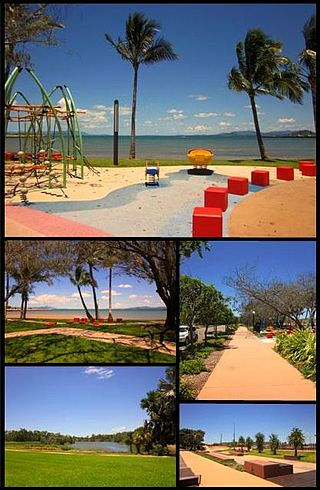
Bowen is a coastal town and locality in the Whitsunday Region, Queensland, Australia. In the 2021 census, the locality of Bowen had a population of 11,205 people.
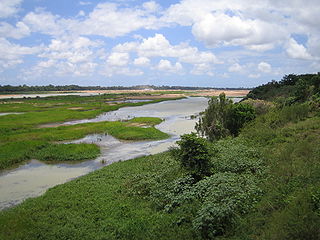
The Burdekin River is a river in North and Far North Queensland, Australia. The river rises on the northern slopes of Boulder Mountain at Valley of Lagoons, part of the western slope of the Seaview Range, and flows into the Coral Sea at Upstart Bay over 200 kilometres (124 mi) to the southeast of the source, with a catchment area of approximately 130,000 square kilometres (50,000 sq mi). The Burdekin River is Australia's largest river by (peak) discharge volume.

Ayr is a rural town and locality in the Shire of Burdekin, Queensland, Australia. It is the centre of a sugarcane-growing region and the administrative centre for the Burdekin Shire Council. In the 2021 census, the locality of Ayr had a population of 8,603 people.
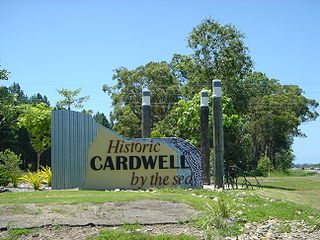
Cardwell is a coastal town and rural locality in the Cassowary Coast Region, Queensland, Australia. In the 2021 census, the locality of Cardwell had a population of 1,320 people.

Whitsunday Island is the largest island in the Whitsunday group of islands located off the coast of Central Queensland, Australia.
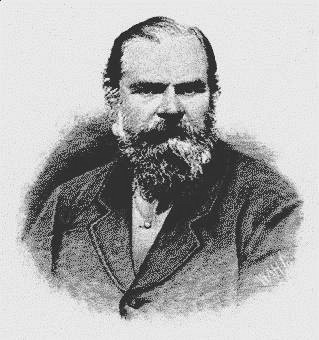
Frederick Walker was a British public servant of the Colony of New South Wales, property manager, Commandant of the Native Police, squatter and explorer, today best known as the first and much feared Commandant of the death squads known as the Native Police Force that operated in the colonies of New South Wales and Queensland. He was appointed commandant of this force by the NSW government in 1848 and was dismissed in 1854. During this time period the Native Police were engaged is what was known as “dispersals” of other indigenous people from their lands and were active from the Murrumbidgee/Murray River areas through the Darling River districts and into what is now the far North Coast of NSW and southern and central Queensland. Despite this large area, most operations under Walker's command occurred on the northern side of the Macintyre River. Detachments of up to 12 troopers worked on the Clarence and Macleay Rivers in NSW until the early 1860s and patrols still extended as far south as Bourke until at least 1868. After his dismissal from the Native Police, Walker became involved in the pastoral industry as a squatter, as well as organising a private native police force and leading a number of expeditions into Northern Queensland.

Australian native police were specialised mounted military units consisting of detachments of Aboriginal troopers under the command of White officers appointed by colonial governments. These units existed in various forms in colonial Australia during the nineteenth and, in some cases, into the twentieth centuries. From temporary base camps and barracks, Native Police were primarily used to patrol the often vast geographical areas along the colonial frontier in order to conduct raids against aboriginals or tribes that had broken the law and punitive expeditions against Aboriginal people. The Native Police proved to be a brutally destructive instrument in the disintegration and dispossession of Indigenous Australians. Armed with rifles, carbines and swords, they were also deployed to escort surveying groups, gold convoys and groups of pastoralists and prospectors.
The Hornet Bank massacre was the killing of eleven British settlers, which included eight members of the Fraser family, by a group of mostly Yiman Indigenous Australians. The massacre occurred at about one or two o'clock in the morning of 27 October 1857 at Hornet Bank station on the upper Dawson River near Eurombah in central Queensland, Australia. It has been moderately estimated that 150 Aboriginal people succumbed in subsequent punitive expeditions conducted by Native Police, private settler militias, and by William Fraser in or around Eurombah district. Indiscriminate shootings of "over 300" Aboriginal men, women, and children, however, were reportedly conducted by private punitive expedition some 400 kilometres eastward at various stations in the Wide Bay district alone. The result was the near-extermination of the entire Yiman tribe and language group by 1858; this claim was disputed, however, and descendants of this group have recently been recognised by the High Court of Australia to be the original custodians of the land surrounding the town of Taroom.
Joe Flick was an Indigenous Australian outlaw famous for being one of the few people to have killed a Native Police officer. He also wounded the well-known British colonist Frank Hann in a shootout at Lawn Hill Station in the colony of Queensland.
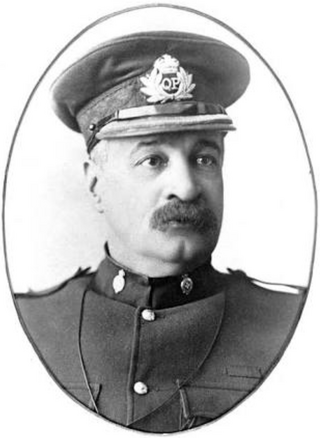
Frederic Charles Urquhart was a Native Police officer, Queensland Police Commissioner and Administrator of the Northern Territory.

George Augustus Frederick Elphinstone Dalrymple was a colonist, explorer, public servant and politician, member of the Legislative Assembly of Queensland. He founded the towns of Bowen and Cardwell, and pioneered the opening up of the Herbert, Burdekin, Johnstone and Daintree River regions to British colonisation. During this time he was responsible for many killings of Aboriginal people who lived in the area.

Alexander Douglas Douglas was a naval officer, an inspector in the Native Police and a chief inspector of police in Queensland.
Wentworth D'Arcy Uhr was an officer in the paramilitary Native Police in the British colony of Queensland. After being demoted for poor conduct, he resigned from this force and became a drover, leading the first herds of cattle into the region now known as the Northern Territory. He later became, amongst other vocations, a gold prospector, butcher and hotelier. Throughout his life, Uhr actively engaged in multiple incidents of frontier violence including several massacres of Aboriginals. He was also the subject of numerous court cases defending charges which ranged from murder and assault to race-fixing and fraud. In later life he moved to Western Australia and became a business partner with Charles Kidman, brother of the famous pastoralist, Sidney Kidman.
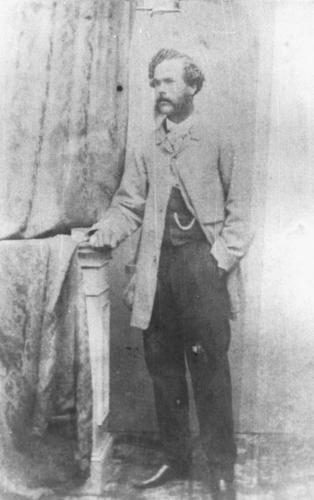
John O'Connell Bligh was a Native Police officer in the British colonies of New South Wales and Queensland. He achieved the rank of Commandant of this colonial paramilitary force from 1861 to 1864. Bligh is probably best known for an incident in Maryborough, where he shot a number of Aboriginal Australians along the main street and into the adjoining Mary River. After retiring from the Native Police, Bligh became a police magistrate in the towns of Gayndah and Gympie.

Edric Norfolk Vaux Morisset was a high-ranking officer in both the paramilitary and civilian police forces of the New South Wales and Queensland colonies of the British Empire. He was Commandant of the paramilitary Native Police from 1857 to 1861 and concurrently became the first Inspector General of Police in Queensland in 1860. Morisset afterwards was appointed Superintendent of Police at Bathurst and then later on at Maitland. From 1883 until his death in 1887, Morisset was Superintendent of the Southern Districts and Deputy Inspector General of Police in New South Wales.
Walter David Taylor Powell was an English mariner and paramilitary Native Police officer in the British colonies of New South Wales and Queensland. He played a significant part in the practical implementation of British colonial rule in the coastal areas of Queensland. His role as an officer in the Native Police was central in a number of important moments in colonial Queensland history including that of the brutal crushing of localised Aboriginal resistance after the Hornet Bank massacre, the foundation of Rockhampton and the creation of the Bowen settlement. He also had major contributions in the founding of Cardwell, the coastal and South Seas trade, and the British colonisation of the Torres Strait.

John Murray was a Scottish officer in the Australian native police in the British colonies of New South Wales and Queensland. He was an integral part of this paramilitary force for nearly twenty years, supporting European colonisation in south-eastern, central and northern Queensland. He also had an important role in recruiting troopers for the Native Police from the Riverina District in New South Wales.

George Poultney Malcolm Murray or simply G.P.M. Murray was a British-born senior officer in both the paramilitary Native Police and civilian Queensland Police Force.
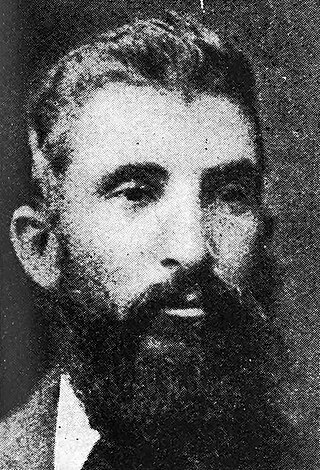
Robert Arthur Johnstone was an officer in the Native Police paramilitary force which operated in the British colony of Queensland. He was stationed at various locations in central and northern Queensland between 1867 and 1880 conducting regular punitive expeditions against clans of Indigenous Australians who resisted colonisation. He also participated in several surveying expeditions in Far North Queensland, including those under the leadership of George Elphinstone Dalrymple.

William Edington Armit was a soldier, sailor, Native Police officer in the British colony of Queensland, explorer, naturalist and colonial administrator in British New Guinea. Armit is regarded as one of the most violent officers of the paramilitary Native Police force.

















